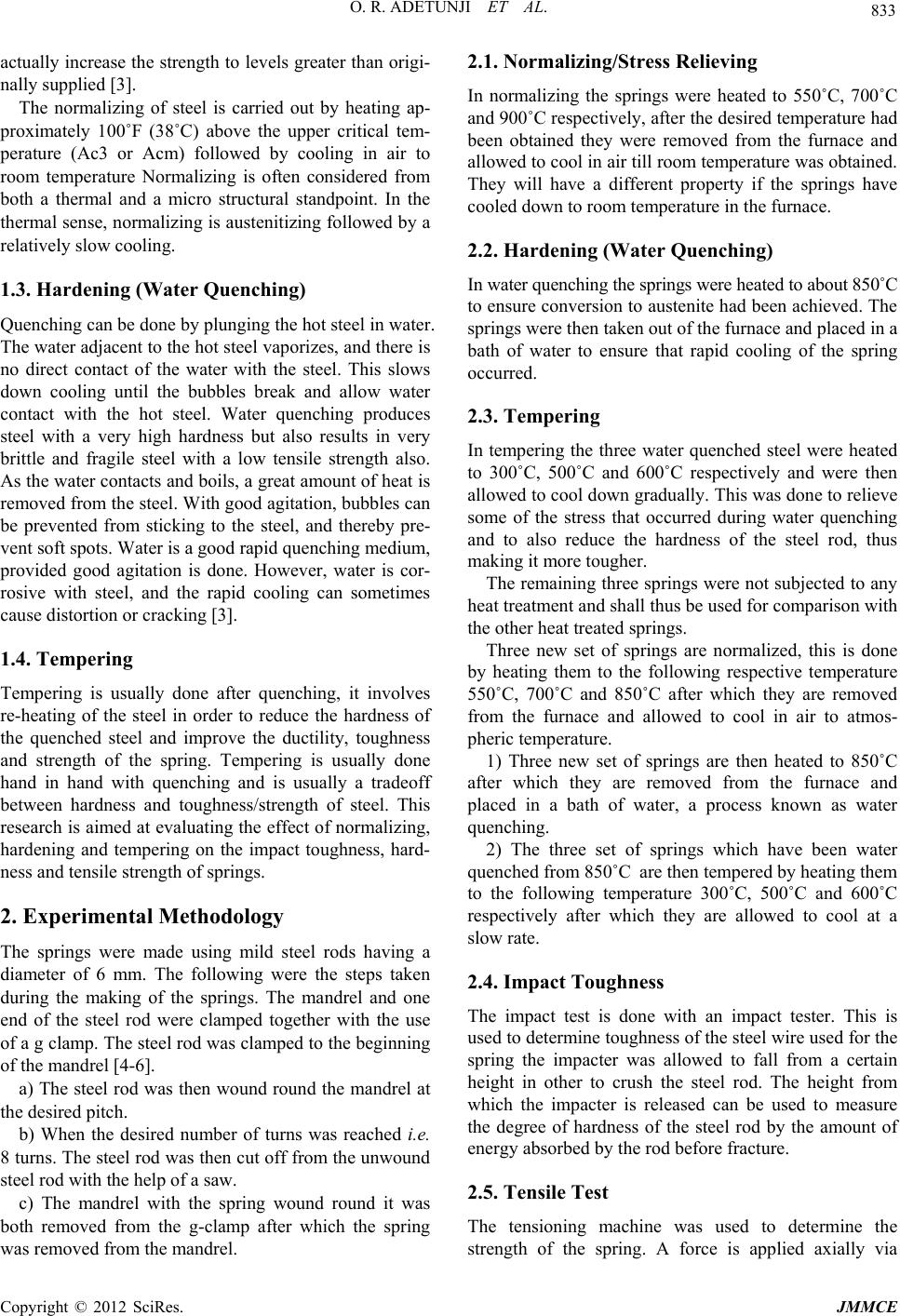
O. R. ADETUNJI ET AL. 833
actually increase the strength to leve ls greater than origi-
nally supplied [3].
The normalizing of steel is carried out by heating ap-
proximately 100˚F (38˚C) above the upper critical tem-
perature (Ac3 or Acm) followed by cooling in air to
room temperature Normalizing is often considered from
both a thermal and a micro structural standpoint. In the
thermal sense, normalizing is austenitizin g followed by a
relatively slow cooling.
1.3. Hardening (Water Quenching)
Quenching can be done by plunging the hot steel in water.
The water adjacent to the hot steel vaporizes, and there is
no direct contact of the water with the steel. This slows
down cooling until the bubbles break and allow water
contact with the hot steel. Water quenching produces
steel with a very high hardness but also results in very
brittle and fragile steel with a low tensile strength also.
As the water contacts and boils, a great amount of heat is
removed from the steel. With good agitation, bubbles can
be prevented from sticking to the steel, and thereby pre-
vent soft spots. Water is a good rapid quenching medium,
provided good agitation is done. However, water is cor-
rosive with steel, and the rapid cooling can sometimes
cause disto rtion or cracking [ 3].
1.4. Tempering
Tempering is usually done after quenching, it involves
re-heating of the steel in order to reduce the hardness of
the quenched steel and improve the ductility, toughness
and strength of the spring. Tempering is usually done
hand in hand with quenching and is usually a tradeoff
between hardness and toughness/strength of steel. This
research is aimed at evaluating the effect of normalizing,
hardening and tempering on the impact toughness, hard-
ness and tensile strength of springs.
2. Experimental Methodology
The springs were made using mild steel rods having a
diameter of 6 mm. The following were the steps taken
during the making of the springs. The mandrel and one
end of the steel rod were clamped together with the use
of a g clamp. The steel rod was clamped to the beginning
of the mandrel [4-6].
a) The steel rod was then wound round the mandrel at
the desired pitch.
b) When the desired number of turns was reached i.e.
8 turns. The steel rod wa s then cut off from the unwound
steel rod with the help of a saw.
c) The mandrel with the spring wound round it was
both removed from the g-clamp after which the spring
was remove d from the mandrel.
2.1. Normalizing/Stress Relieving
In normalizing the springs were heated to 550˚C, 700˚C
and 900˚C respectively, after the desired temperature had
been obtained they were removed from the furnace and
allowed to cool in air till room temperature was obtained.
They will have a different property if the springs have
cooled down to room temperature in the furnace.
2.2. Hardening (Water Quenching)
In water quenching t he spri ng s were heat ed to about 850˚C
to ensure conver sion to austenite had been achieved. Th e
springs were then taken out of the furnace and placed in a
bath of water to ensure that rapid cooling of the spring
occurred.
2.3. Tempering
In tempering the three water quenched steel were heated
to 300˚C, 500˚C and 600˚C respectively and were then
allowed to cool down gradually. Th is was done to relieve
some of the stress that occurred during water quenching
and to also reduce the hardness of the steel rod, thus
making it more tougher.
The remaining three springs were not subj ected to any
heat treatment and shall thus be used for comparison with
the other heat treated springs.
Three new set of springs are normalized, this is done
by heating them to the following respective temperature
550˚C, 700˚C and 850˚C after which they are removed
from the furnace and allowed to cool in air to atmos-
pheric temperature.
1) Three new set of springs are then heated to 850˚C
after which they are removed from the furnace and
placed in a bath of water, a process known as water
quenching.
2) The three set of springs which have been water
quenched from 850˚C are then tempered by heating them
to the following temperature 300˚C, 500˚C and 600˚C
respectively after which they are allowed to cool at a
slow rate.
2.4. Impact Toughness
The impact test is done with an impact tester. This is
used to determine toughness of the steel wire used for the
spring the impacter was allowed to fall from a certain
height in other to crush the steel rod. The height from
which the impacter is released can be used to measure
the degree of hardness of the steel rod by the amount of
energy absorbed by the rod before fracture.
2.5. Tensile Test
The tensioning machine was used to determine the
strength of the spring. A force is applied axially via
Copyright © 2012 SciRes. JMMCE